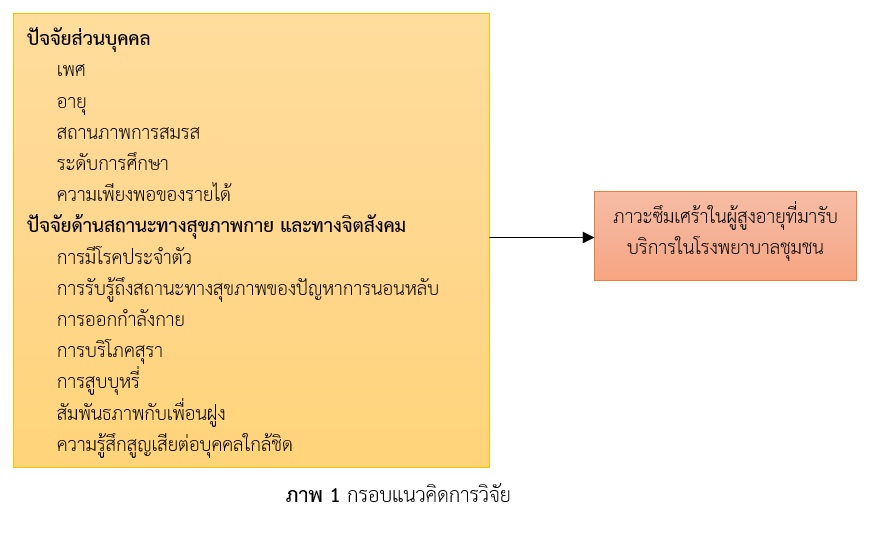ความชุกและปัจจัยที่มีความสัมพันธ์กับภาวะซึมเศร้าของผู้สูงอายุที่มาใช้บริการ ในโรงพยาบาลชุมชน
คำสำคัญ:
โรคซึมเศร้า, ความชุก, ผู้สูงอายุ, ปัจจัยบทคัดย่อ
การวิจัยเชิงสำรวจภาคตัดขวางนี้ มีวัตถุประสงค์เพื่อศึกษาความชุก ปัจจัยที่มีความสัมพันธ์กับภาวะซึมเศร้าของผู้สูงอายุ และระดับความรุนแรงของภาวะซึมเศร้าในผู้สูงอายุ ที่มาบริการในโรงพยาบาลชุมชนจำนวน 410 ราย ใช้วิธีการสุ่มตัวอย่างแบบมีระบบ เครื่องมือที่ใช้คือแบบสอบถามข้อมูลทั่วไป แบบคัดกรองภาวะซึมเศร้า 2Q แบบประเมินโรคซึมเศร้า 9Q แบบประเมินการฆ่าตัวตาย 8Q วิเคราะห์ข้อมูลโดยสถิติ จำนวนร้อยละ ค่าเฉลี่ย ส่วนเบี่ยงเบนมาตรฐาน และสถิติ Multiple Logistic Regression Analysis ผลการวิจัยพบว่า
1. ความชุกของภาวะซึมเศร้าในผู้สูงอายุ ที่มารับบริการในโรงพยาบาลชุมชน พบความชุก ร้อยละ 25.61 โดยในเพศชายมีค่าความชุกร้อยละ 7.32 ในเพศหญิงมีค่าความชุกร้อยละ 18.29
2. ปัจจัยที่มีความสัมพันธ์กับภาวะซึมเศร้าในผู้สูงอายุ ที่มารับบริการในโรงพยาบาลชุมชน ได้แก่ สถานะสมรสหย่าหรือแยกกันอยู่ การดื่มสุราเป็นประจำ การทำใจไม่ได้ต่อการสูญเสียคนใกล้ชิด ความพอใจในสุขภาพระดับต่ำ การนอนไม่หลับ และความไม่เพียงพอของรายได้ โดยพบว่า สถานะสมรสหย่าหรือแยกกันอยู่ (OR=4.65, p<01, 95% CI=3.14–68.27) การดื่มสุราเป็นประจำ (OR=10.81, p<0.01, 95% CI=2.68-43.56) การทำใจไม่ได้ต่อการสูญเสียคนใกล้ชิด (OR=7.15, p<0.001, 95% CI=2.53-20.21) ความพอใจในสุขภาพในระดับต่ำ (OR=5.71, p<0.05, 95% CI=1.31-24.86) การนอนไม่หลับ (OR=4.67, p<0.01, 95% CI=1.64-13.32) และ ความไม่เพียงพอของรายได้ (OR=3.67, p<0.05, 95% CI=1.22-11.07) เป็นปัจจัยที่มีความสัมพันธ์กับโรคซึมเศร้าอย่างมีนัยสำคัญทางสถิติ ที่ระดับ 0.05
3. ระดับความรุนแรงของภาวะซึมเศร้าในประชากรสูงอายุจังหวัดบึงกาฬ พบร้อยละ 25.60 และประเมินโรคซึมเศร้าด้วย 9Q พบว่าระดับความรุนแรงน้อยมาก ระดับน้อย ระดับปานกลาง และระดับรุนแรง คิดเป็นร้อยละ 76.19,28, 7.61 และ 1.90 ตามลำดับ เพศชาย มีแนวโน้มของภาวะซึมเศร้าร้อยละ 19.36 ไม่พบการคิดฆ่าตัวตาย ส่วนเพศหญิงมีแนวโน้มของภาวะซึมเศร้าร้อยละ 29.42 พบว่าเพศหญิงมีความคิดฆ่าตัวตายร้อยละ 1.90 จากการประเมินการฆ่าตัวตายด้วย 8Q
ปัจจัยด้านสถานะสมรสหย่าหรือแยกกันอยู่ การดื่มสุราเป็นประจำ การทำใจไม่ได้ต่อการสูญเสียคนใกล้ชิด ความพอใจในสุขภาพระดับต่ำ การนอนไม่หลับ และความไม่เพียงพอของรายได้ เหล่านี้สามารถนำไปใช้ในการวางแผนการส่งเสริม ป้องกัน และหาแนวทางในการดูแลผู้สูงอายุเหล่านี้ ให้สามารถใช้ชีวิตอยู่ในครอบครัว และชุมชนได้อย่างมีความสุขต่อไป
References
Arunpongpaisal, S., Kongsuk, T., Maneethorn, N., Maneethorn, B., Wannasawek, K., Leejongpermpoon, J., et al. (2009). Development and Validity of Two-Question Screening test for Depressive Disorders in Northeastern Thai Community. Asian J Psychiatr, 2, 149-52. (In Thai)
Beck, A. T., Ward, C. H., Mendelshon, M., Mock, J., & Erbaugh, J. (1961). An Inventory for Measuring Depression. Arch Gen Psychiatry, 4, 561-571.
Beck, A., & Alford, B. A. (2009). Depression: Causes and Treatment. Second Edition. University of Philadelphia, Pennsylvania: Pennsylvania Press.
Bhamani, M. A., Karim, M. S., & Khan, M. M. (2013). Depression in the Elderly in Karachi, Pakistan: a Cross Sectional Study. BMC Psychiatry, 13(1), 181-189.
Charernboon, T. (2011). Measures and Screening Tests for Depression in Thailand: A User’s Guide. Thammasat Medical Journal, 11(4), 667-676. (In Thai)
Cole, M. G., & Dendukuri, N. (2003). Risk Factors for Depression among Elderly Community Subjects: a Systematic Review and Meta-Analysis. American Journal of Psychiatry, 160(6), 1147-1156.
Han, K. M., Han, C., Shin, C., Jee, H. J., An, H., Yoon, H. K., & Kim, S. H. (2018). Social Capital, Socioeconomic Status, and Depression in Community-Living Elderly. Journal of Psychiatric Research, 98, 133-140.
Kansri, J., Malai, C., & Soonthornchaiya, R. (2018). Geriatric Depression and its Related Factors among Thai Elderly in Chainat Province. In ANPOR Annual Conference Proceedings, (pp. 45-45). (In Thai)
Katana, C., Linnastan, G., & Cooper, C, (2010). Functional Psychiatric Illness in Old Age. In Howard M. F, Kenneth R, Kenneth W, Editors. Brocklehurst’s Textbook of Geriatric Medicine and Gerontology 7th ed. Philadelphia: Saunders; p 433-6
Kongsuk, T., Kenbubpha, K., Sukhawaha, S., Yingyuen, R., Sukjai, S., Leejongpermpoon, J., et al. (2008). The Development and Validity of the 9-Question Depressive Disorder Diagnostic test in Thai I-San Dialects. Proceedings of The WPA Thematic Conference on Depression and Other Common Mental Disorders in Primary Care, Held in Spain, Granada, from June 18th to 21th, 2008; The 11th Congress of the ASEAN Federation for Psychiatry and Mental Health 26th-29th August, Thailand. Bangkok. (In Thai)
Liang, G., Arunpongpaisal, S., Kessomboon, P., Pinitsoontorn, S., & Kuhirunyaratn, P. (2009). Depression and Cognitive Impairment among the Community Dwelling Elderly in a Community of Khon Kaen: A Primary Care Setting Descriptive Study. Journal of Psychiatric Association Thailand, 54(4), 357-366. (In Thai)
Mousservi, S., Chatterji, S., Verdes, E., Tandon, A., Patel, V., & Ustun, B. (2007). Depression, Chronic Disease, and Decrements in Health: Result from the World Health Surveys. Lancet, 370, 851-8.
Murray, C. J., & Lopez, A. D. (1997). Alternative Projections of Mortality and Disability by Cause 1990-2020: Global Burden of Diseases Study. Lancet, 349, 1498-1504.
Smith, M., Segal, J., & Robinson, L. (2017). Suicide prevention. Help Guide.
Suttajit, S., Punpuing, S., Jirapramukpitak, T., Tangchonlatip, K., Darawuttimaprakorn, N., Stewart, R., & Abas, M. A. (2010). Impairment, Disability, Social Support and Depression among Older Parents in Rural Thailand. Psychological Medicine, 40(10), 1711-1721. (In Thai)
Wongpakaran, N. (2008). Geriatric Psychiatry in Thailand. J Psychiatr Assoc Thailand, 53, S39-46. (In Thai)
Wongpoom, T., Sukying, C., & Udomsubpayakul, U. (2011). Prevalence of Depression among the Elderly in Chiang Mai Province. J Psychiatr Assoc Thailand, 56, 103-16. (In Thai)
World Health Organization. (2010). The Global Burden of Disease. Retrieved March 24, 2010 from http//www.who.int/healthinfo/global_burden_diseaseGBD_report_2004update_ full.pdf
Yamane, T. (1973). Statistics an Introductory Analysis 3th. Singapore: Times Printers Sdn.

Downloads
เผยแพร่แล้ว
ฉบับ
บท
License
1. บทความหรือข้อคิดเห็นใด ๆ ที่ปรากฏในวารสารเครือข่าย วิทยาลัยพยาบาลและการสาธารณสุขภาคใต้ ที่เป็นวรรณกรรมของผู้เขียน บรรณาธิการหรือเครือข่ายวิทยาลัยพยาบาลและวิทยาลัยการสาธารณสุขภาคใต้ ไม่จำเป็นต้องเห็นด้วย
2. บทความที่ได้รับการตีพิมพ์ถือเป็นลิขสิทธิ์ของ วารสารเครือข่ายวิทยาลัยพยาบาลและการสาธารณสุขภาคใต้






